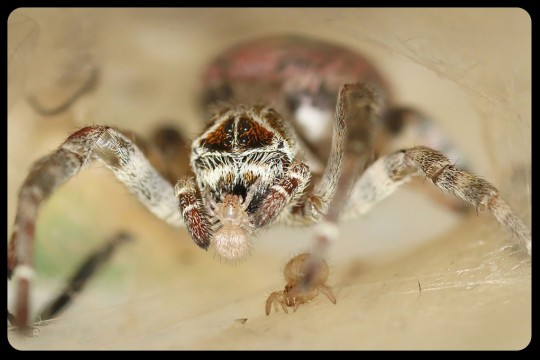#more like arachno-feminism
Explore tagged Tumblr posts
Text
African Social Spiders: these spiders live in colonies that can contain up to 2,000 spiders, most of which are female; they hunt, forage, maintain their web, and raise their offspring as a group, without any dominance hierarchy or caste system

This communal behavior is extremely rare among spiders, which are normally solitary creatures. The African social spider (Stegodyphus dumicola) is one of the few species that has been identified as a true "social spider," forming colonies and living in communal nests where the spiders work together to hunt, forage, build webs, and care for their offspring.

Above: an African social spider feeding the young spiderlings of her colony by regurgitating food for them, exhibiting a level of maternal/allomaternal care that is relatively uncommon in both spiders and insects
African social spiders can be found in various parts of southwestern Africa, where they will often build a dense silk nest in the branches of a thorn tree and/or shrub. Most of the spiders in the colony are female (more than 85%, according to some studies) and the species itself also has a female-biased primary sex ratio, as researchers have found that female embryos develop in more than 80% of the eggs that the spiders produce.

Above: a group of African social spiders working together to subdue their prey, which will be taken back to the nest so that it can be shared with the rest of the colony
There is no evidence that any dominance hierarchy or caste system exists within S. dumicola colonies. The spiders all cooperate to complete a variety of tasks, such as hunting, repairing the web, foraging, defending the colony, caring for the colony's offspring, etc. While none of them are exclusively assigned to a single task, many have a primary role that they fill, often based on their physical size and condition.

Above: close-up photo of S. dumicola
This species also engages in extreme allomaternal care, meaning that many different spiders (including both mothers and "allomothers") all share the responsibility of caring for the colony's offspring; even the unmated females help out with brood care. The mothers/allomothers tend to the eggsacs, regurgitate food for the baby spiderlings, and even engage in matriphagy, which means that they will eventually be cannibalized by the babies.
From The Encyclopedia of Animal Behavior:
... some proportion of females do not reproduce – sometimes as much as 60% – but remain as helpers, contributing to foraging and brood care (allo-mothering). Both breeding females and virgin allo-mothers regurgitate food for colony offspring and eventually let the young consume their bodies. ...
Young that are raised with both mothers and allo-mothers show higher survival and growth than young raised by their mothers alone, suggesting a clear fitness benefit of cooperative breeding.

Spiders of this species generally measure about 2.5 - 3.5mm long; they can be found in Namibia, Botswana, Zimbabwe, South Africa, Lesotho, and Eswatini.
Sources & More Info:
Science Direct: Social Spiders
Current Biology: Quick Guide to Social Spiders (PDF)
Phys.org: Untangling the Social Lives of Spiders
Proceedings of the Royal Society B: The Age & Evolution of Sociality in Stegodyphus Spiders
Entomology Today: Social Spiders Divide Labor According to Body Size & Condition
Animal Behaviour: Extreme Allomaternal Care by Unmated Females in a Cooperatively Breeding Spider
National Geographic: Baby Spiders Eat their Mothers
University of Portsmouth: Social Spiders Have Different Ways of Hunting in Groups
Behavioral Ecology: Spider Societies Mitigate Risk by Prioritizing Caution
Behavioral Processes: Warring Arthropod Societies
Behavioral Ecology and Sociobiology: Does the African Social Spider Stegodyphus dumicola Control the Sex of Individual Offspring?
#arachnology#spiders#african social spiders#stegodyphus#dumicola#arthropods#arachnids#allomaternal#matriphagy#communal spiders#social spiders#cool bugs#animal facts#tw arachnophobia#cw spiders#anarcho-feminism?#more like arachno-feminism#just a bunch of radfem commie cannibals
258 notes
·
View notes